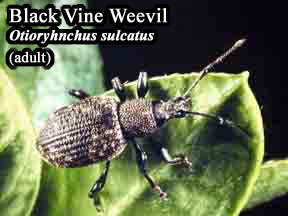Yarrow (Achillea)
Plant Health Problems
See Perennials for a detailed discussion of problems that may occur and are common to most herbaceous ornamentals.
Diseases caused by Fungi:
Basal or root rot, Rhizoctonia solani or Pythium spp.
Roots and basal stems are rotted, black or brown and collapsed. Sunken lesions may occur at the soil line. These fungi must be distinguished microscopically. However, Pythium tends to predominate in wet soils and Rhizoctonia in well-drained soils.
Control with fungicides is not reliably effective and may be prohibitively expensive, so removal of infected plants is important.
Leaf spots, Alternaria, Colletotrichum, or Septoria spp.
Leaf spots are very common, typically sharply delimited necrotic areas on plant leaves caused by a wide variety of pathogenic species. Leaf spots usually are favored by wet conditions and may become important if a large number of lesions are present or if they start to coalesce.
Under those conditions, control may also be achieved with the use of fungicides applied as soon as symptoms are visible. Among the compounds registered for use in Connecticut are thiophanate-methyl and sulfur. Consult the label for dosage rates and safety precautions.
Powdery mildew, Erysiphe or Oidium spp.
These fungi are obligate plant parasites which grow vegetatively on the plant leaf surface, sending haustoria, structures which absorb food from the host, into epidermal cells. The white mildew seen on the leaf is a combination of vegetative mycelium and spores borne in chains on upright conidiophores. Wind-dispersed mildew spores can germinate without free water under high humidity conditions, and disease is often severe when conditions are humid but dry. Small black over-wintering structures called perithecia are often found in powdery mildew affected areas.
Control may also be achieved with the use of fungicides applied as soon as symptoms are visible. Among the compounds registered for use in Connecticut are potassium bicarbonate, ultra fine oil, sulfur, triadimefon, or thiophanate-methyl fungicides. Consult the label for dosage rates, safety precautions, and directions for use.
Rust, Puccinia cnini-oleracei.
The term rust refers to both the disease and pathogen causing the disease. Symptoms of rust infection include rust-colored spores or gelatinous horns in powdery pustules on leaves or stems. Surrounding tissue is discolored and yellowed, and plants are often stunted.
Control may be achieved with the use of fungicides applied as soon as symptoms are visible. Among the compounds registered for use in Connecticut are sulfur and mancozeb. Consult the label for dosage rates, safety precautions, and directions for use.
Diseases caused by Bacteria:
Crown gall, Agrobacterium tumefaciens.
The bacteria which cause this disease instigate a rapid increase in unorganized plant cell division which results in a rough-surfaced gall ranging from almost indistinguishable up to several inches in diameter on roots, at the soil line or in shoot tissue.
Bacteria cannot live for more than a couple of years without a host, so removal of infected plants, rotation and inspection of planting stock is the most effective control of this disease.
Insect Problems: Black vine weevil, Otiorhynchus sulcatus.
Black vine weevil, Otiorhynchus sulcatus.
The larvae of this weevil often injure yarrow in nurseries and ornamental plantings by feeding on the roots. The tops of injured plants first turn yellow, then brown, and the severely injured plants die. Leaf notching by adults can also be unsightly. The 1/2" long adult weevil is black, with a beaded appearance to the thorax and scattered spots of yellow hairs on the wing covers. Only females are known. Adults are flightless and feed nocturnally. The legless grub is white with a brown head and is curved like grubs of other weevils. Adults and large larvae overwinter, emerging from May - July. The adults have to feed for 3-4 weeks before being able to lay eggs. Treating the soil with insect pathogenic nematodes may control the larvae and should be the first line of defense for landscape plantings. Acephate and fluvalinate are among the compounds registered for control of this pest in Connecticut, and may applied when there is adult feeding and before egg laying starts. The usual timing for these foliar sprays is during May, June and July at three week intervals. Insecticide resistance is very common; be aware that adults may appear to be dead following contact with fluvalinate, but may recover from poisoning within a few days. Consult the labels for dosage rates and safety precautions.

